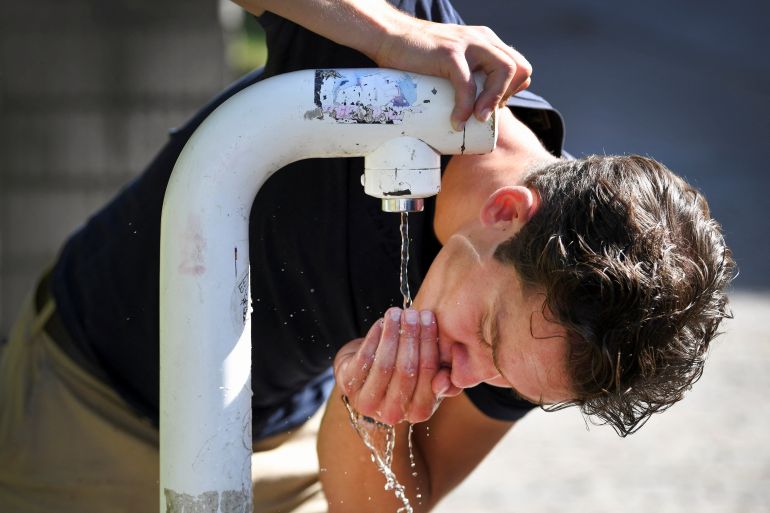How to keep cool and safe in a heatwave
As temperatures keep rising around the world, we take a look at the risks of heatwaves and the main recommendations to keep safe.

Europe is sweltering under a record-breaking heatwave, with a number of governments issuing health emergency alerts.
Below, we take a look at the risks and the ways to keep safe.
Keep reading
list of 3 itemsWhat’s causing the current heatwave?
‘Heat apocalypse’: Europe in the grip of record-breaking heatwave
What are the risks?
- Heat exhaustion, which can include dizziness, headaches, shaking and thirst, can affect anyone and is usually not dangerous if the person cools down within 30 minutes.
- Heatstroke, when the body’s core temperature goes above 40.6 degrees Celsius (105 degrees Fahrenheit), is a medical emergency and can lead to long-term organ damage and death.
Who is at risk?
- Some people are more vulnerable, including babies and elderly people, as well as people who have to stay active or are more exposed, such as homeless people or construction workers among others.
- People with health conditions, including respiratory and cardiovascular diseases, as well as diabetes, are also at high risk of complications caused by excess heat.
- Globally, less than half a million deaths a year are estimated to be due to excess heat, according to a study last year in The Lancet medical journal, although data is lacking from many low-income countries. Far more people die of cold, but that is forecast to change, the researchers said.
What are the signs of heat exhaustion?
According to the Centers for Disease Control and Prevention (CDC), heat exhaustion occurs when the body responds to an excessive loss of water and salt, and it tends to affect the elderly, people with high pressure and those working in hot environments.
As per England’s National Health Service (NHS), the signs of heat exhaustion are:
- headache
- dizziness and confusion
- loss of appetite and feeling sick
- excessive sweating and pale skin
- fast breathing or pulse
- a high temperature of 38C (100F) and above
What are the signs of heat stroke?
The CDC says a heat stroke is the most serious heat-related illness.
During a heat stroke, the body temperature rises quickly, the sweating mechanism fails, and the body cannot cool down. The body temperature can reach 41C (106F) or higher within 10 to 15 minutes. The event can cause permanent disability or death if the person is not treated.
The common symptoms of a heat stroke, according to the CDC and the NHS are:
- Confusion, altered mental status
- Loss of consciousness
- Fast breathing or shortness of breath
- Seizure
How can you prevent heat strokes and exhaustion?
According to health authorities, some actions can be taken to prevent heat strokes and heat exhaustion during heatwaves.
Those include:
- Keeping hydrated by drinking cold drinks, especially when exercising
- Taking cool showers
- Wearing light-coloured, loose clothing
- Walking in the shade, applying sunscreen regularly and wearing a hat
- Not leaving children or animals in parked vehicles
How do you stay cool during a heatwave?
According to the NHS, one of the main recommendations is to stay out of the sun during the hot part of the day and avoid exercising before it cools down.
However, if you have to go out during this time, experts advise walking in the shade, applying sunscreen and wearing suitable clothing, including a hat. If you cannot avoid outdoor activities, they recommend doing them in the cooler part of the days, including early in the morning or evening.
Keeping hydrated is also important while avoiding excess alcohol, caffeine and hot drinks is recommended. The World Health Organization (WHO) also advises eating small meals more often while avoiding foods high in proteins.
For keeping a house cool, health authorities advise to:
- keep windows that are exposed to the sun closed during the day, and open them at night when the temperature has dropped
- keep curtains closed but be aware of dark curtains as they absorb the heat
- place a thermometer in the living room and bedroom to keep track of the temperature; according to the WHO, the room temperature should be kept below 32C (89F) during the day and 24C (75F) at night
- turn off non-essential electrical equipment as they also generate heat
- authorities also advise keeping indoor plants and bowls of water in the house as evaporation helps keep the air cool
- if possible, move into a cooler room, especially for sleeping
It is also recommended to keep an eye on family, friends and neighbours as vulnerable people might need assistance during hot days.